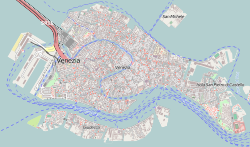This article needs additional citations for verification .(December 2018) |
| Church of San Giacomo di Rialto | |
|---|---|
 | |
| Religion | |
| Affiliation | Roman Catholic |
| Province | Venice |
| Location | |
| Location | Venice, Italy |
| Geographic coordinates | 45°26′18.5″N12°20′7.7″E / 45.438472°N 12.335472°E |
| Architecture | |
| Type | Church |
San Giacomo di Rialto is a church in the sestiere of San Polo, Venice, northern Italy. The inclusion of Rialto in the name distinguishes this church from San Giacomo dell'Orio which is situated in the sestiere of Santa Croce, on the same side of the Grand Canal. The church's front forms the eastern side of Rialto Square and is the only building on that square that escaped the devastating fire of 1514.
Contents
It has a large 15th-century clock above the entrance, a useful item in the Venetian business district but regarded as a standing joke for its inaccuracy. [1] The Gothic portico is one of the few surviving examples in Venice. It has a Latin cross plan with a central dome. Inside, the Veneto-Byzantine capitals on the six columns of ancient Greek marble date from the 11th century.






